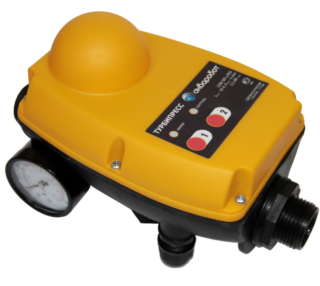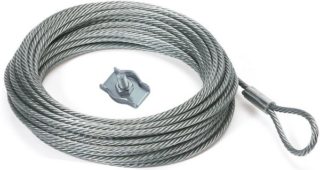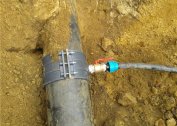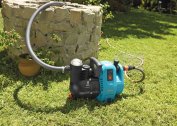Submersible pumps are lowered to a sufficiently large depth, so without some accessories their installation is impossible to carry out. The list of accessories is small. Each of them has its own specific functions, so accessories cannot be replaced with other products.
Types of components for a well pump
Additional elements to downhole pumps can be divided into two categories:
- automation and electrics;
- mechanical part and shutoff valves.
The first includes wire for borehole pumps and automation equipment control. To the second cable, hose or plastic pipe, check valve. All pumping units of this type are equipped with a waterproof cable, but it is short (length does not exceed 4 m), which is not enough to ensure immersion of the device to a great depth.
Electrical cable
The building materials market offers a wide range of waterproof cables. Any one will do. But you need to choose a product according to the cross-section of the wire that came with the pump. This parameter must be indicated in the passport of the pump unit and it is usually adjusted to the power of the unit.
The connection of two pieces of cable is carried out using a special filler sleeve or heat shrink. The main task of the manufacturer of the work is not to confuse the wires of the wire. Therefore, the acquired piece of cable must be adjusted to the equipped core in color.
Be sure to consider the immersion depth of the pump. The length of the purchased piece of the submersible cable for the downhole pump must be no less than the depth, taking into account the length of the wire that the pumping equipment is equipped with.
Control automation
The main task of automation for the pump is to ensure the safe operation of the latter. The automatic part controls the processes, turns off the pump, if there is not enough water in the well or the device’s electric motor suddenly overheats.
The automation includes:
- Control block;
- a relay that controls the pressure of the water inside the pump;
- voltage stabilizer, with the help of which the network loads acting on the electric motor of the unit are balanced;
- a device that turns off the pump if it starts to run dry.
All automation elements are located outside the pump housing and are mounted inside the house or extension to the cottage. Usually this type of spare part is sold as a set. It is important to choose it correctly by the power of the pumping equipment.
Hose or pipe
Hoses for submersible pumps are represented by a huge assortment in which it is easy to get lost. But there are certain criteria that can help during the initial selection stage.
First of all, you need to remove watering hoses from the list. They can only be used in the warmer months and connected to the pump via a tee. They can not be laid in the ground.
For a borehole pump, the best option is rigid hoses that easily withstand various loads: natural, technical. It is necessary to pay attention to the following parameters:
- Degree of rigidity. Products should not bend, contract, increase in volume under water pressure during operation. Their dimensional parameters should not be changed. Stiffness of hoses is given in different ways: reinforcing with a wire, crimping, increasing wall thickness.
- Frost resistance. This criterion is taken into account only if the well and pump will be used all year round. The hose under the influence of low temperatures should not change its size and technical characteristics.
- Since autonomous water supply is also intended to provide drinking water at home, for this it is necessary to choose a hose that will comply with sanitary and hygienic standards. Do not use rubber hoses that will give water an unpleasant rubber aftertaste and smell. In addition, the rubber begins to decompose under the influence of water, which will negatively affect the quality of the distilled liquid.
If we take into account all claims to the hoses, there are only two types: the product of low pressure polyethylene (HDPE) and the so-called silicone sleeve. The former are preferable because they are the cheapest products and fully comply with the required characteristics. Among all plastic pipes, polyethylene bends well, so they are sold in bays of 50 or 100 m long. Using a flexible HDPE pipe, you can cut it to the required length, which will provide a seamless transport loop.
Silicone hose meets sanitary standards, but inferior to polyethylene in terms of stiffness. If the pump head is large enough, the product may not withstand. Therefore, this type of hose is recommended to be used only in the summer water supply system.
Check valve
This type of shutoff valve is installed on the drainage circuit at a distance of 1-1.5 m above the well pump. Its task is to prevent water hammer, and also to prevent water that has filled the hose from draining back into the well. This makes it possible to save a little electricity, because in order to raise water, the pump must first fill the transport artery so that the fluid begins to flow from plumbing fixtures.
The deeper the well, the longer the water will rise through the pipe. And since the hose is full all the time, the time to supply fluid is reduced.
Safety cable
The submersible pump in the hydraulic structure must be somehow fixed. It is impossible to install fasteners inside, therefore the device is suspended from the head of the well, which closes the barrel (shaft) of the structure and acts as a support device. In its design there is a hook to which the cable is attached.
The pump itself does not hang on a cable. The main fastener is the HDPE pipe. At one end, it is attached to the pump, the other passes through the head and is sent to the house. The cable acts as an insurance in case the plastic pipe breaks or detaches from the pump. The cable will hold the pump unit, for it you can pull it out. Inside the well, the cable hangs without tension. He is not connected with anything except the pump and the head. PND pipe and cable are interconnected by plastic clamps, as a whole.
In the market, safety cables for borehole pumps are presented in three varieties:
- steel;
- from stainless steel;
- nylon rope.
Until recently, a steel cable was used quite often. But inside the well, where humidity is high, steel quickly corrodes, which reduces the product’s service life. In addition, rusty steel additionally clogs water. Therefore, steel cables began to be galvanized, which is why their service life has doubled.
A stainless steel cable is considered the best on the market. The price is high, but this is offset by an almost unlimited service life and inertness to water.
The simplest safety cable is a nylon rope. It is also called nylon or polyamide. On the market, it is represented by only two sizes - with a diameter of 5 and 10 mm. If it is necessary to increase the bearing capacity of a product, it is twisted twice or three times.
The disadvantages of the rope are:
- tensile during operation;
- the possibility of breakage when grinding in one place.
The product has more advantages:
- when compared with the average load, the polyamide thread is considered to be very strong, so that it will last for decades inside the well;
- the rope does not rot and does not corrode;
- absolute inertness to water - substances that affect the human body will not get from kapron into water;
- low price.
After the stainless steel cable, the nylon rope is in second place. The main task is to correctly tie it to the head hook and pump ear. To do this, tie a knot and tighten the ends with a plastic clamp.







